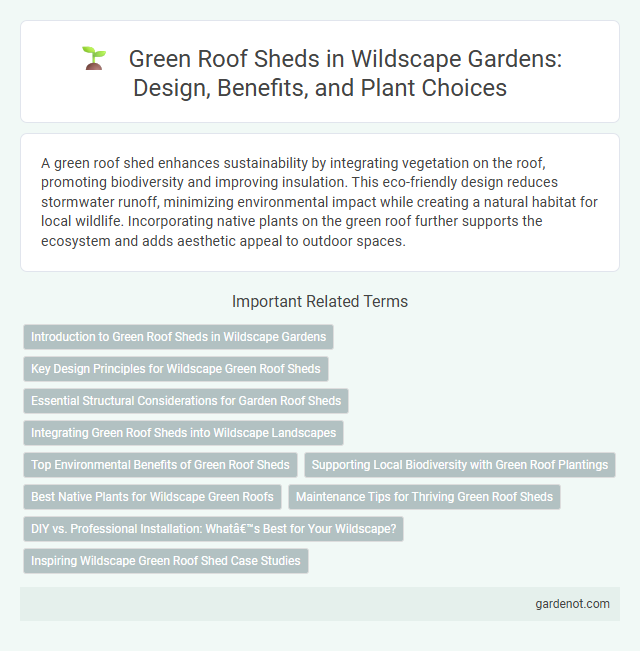A green roof shed enhances sustainability by integrating vegetation on the roof, promoting biodiversity and improving insulation. This eco-friendly design reduces stormwater runoff, minimizing environmental impact while creating a natural habitat for local wildlife. Incorporating native plants on the green roof further supports the ecosystem and adds aesthetic appeal to outdoor spaces.
Introduction to Green Roof Sheds in Wildscape Gardens
Green roof sheds in Wildscape Gardens combine sustainability with aesthetic appeal by featuring living vegetation on their rooftops, enhancing biodiversity and improving air quality. These structures support native plant species, promote habitat creation for pollinators, and reduce stormwater runoff through natural absorption. Integrating green roof sheds into Wildscape Gardens exemplifies eco-friendly landscaping practices that foster environmental resilience and visual harmony.
Key Design Principles for Wildscape Green Roof Sheds
Wildscape green roof sheds integrate native plant species to enhance local biodiversity and create habitats for pollinators and birds. Structural design prioritizes lightweight, durable materials to support vegetation without compromising shed stability. Efficient water management systems, including drainage layers and irrigation, ensure plant health while minimizing runoff and promoting sustainability.
Essential Structural Considerations for Garden Roof Sheds
Green roof sheds require robust waterproof membranes and high-quality root barriers to prevent water infiltration and plant root damage. Structural framing must support the additional weight of soil, vegetation, and retained water, often necessitating reinforced joists and load-bearing beams. Adequate drainage systems and slope design are crucial to avoid water pooling and ensure plant health on garden roof sheds.
Integrating Green Roof Sheds into Wildscape Landscapes
Integrating green roof sheds into wildscape landscapes enhances biodiversity by providing native plant habitats and promoting local insect populations. These eco-friendly structures improve stormwater management and reduce urban heat island effects through natural insulation. Strategically placed green roof sheds create seamless transitions between built environments and natural wildscapes, supporting ecological connectivity.
Top Environmental Benefits of Green Roof Sheds
Green roof sheds significantly reduce urban heat island effects by providing natural insulation and cooling, which lowers energy consumption for heating and cooling. Their vegetative layers improve air quality by filtering pollutants and absorbing CO2, contributing to healthier environments. These roofs enhance biodiversity by creating habitats for pollinators and birds, promoting ecological balance in urban settings.
Supporting Local Biodiversity with Green Roof Plantings
Green roof sheds create vital habitats by incorporating native plant species that attract local pollinators, birds, and beneficial insects, enhancing urban biodiversity. These green roofs help to mitigate the urban heat island effect while providing insulation, which reduces energy consumption. By supporting local flora and fauna, green roof sheds contribute to healthier ecosystems and promote environmental sustainability in urban landscapes.
Best Native Plants for Wildscape Green Roofs
Best native plants for Wildscape green roofs include Sedum species, wildflowers like Echinacea purpurea, and native grasses such as Schizachyrium scoparium. These plants enhance biodiversity, improve insulation, and require minimal maintenance due to their adaptation to local climate conditions. Incorporating native species supports pollinators and contributes to a sustainable, eco-friendly green roof ecosystem.
Maintenance Tips for Thriving Green Roof Sheds
Regular watering and weeding are essential for maintaining a healthy green roof shed, ensuring optimal plant growth and preventing invasive species. Using lightweight, nutrient-rich soil mixes enhances drainage and supports robust root systems vital for the rooftop environment. Periodic inspections for drainage blockages and structural integrity help sustain long-term performance and prevent water damage.
DIY vs. Professional Installation: What’s Best for Your Wildscape?
Choosing between DIY and professional installation for a Wildscape green roof shed depends on budget, expertise, and project complexity. DIY installation offers cost savings and customization opportunities but requires knowledge of waterproofing, drainage, and native plant selection to ensure ecosystem balance. Professional installers provide expert craftsmanship, warranty options, and optimized plant health, enhancing the longevity and ecological benefits of your Wildscape green roof shed.
Inspiring Wildscape Green Roof Shed Case Studies
Wildscape green roof sheds showcase innovative examples of sustainable design, enhancing biodiversity and improving insulation in urban settings. These case studies highlight the integration of native plants, rainwater harvesting systems, and eco-friendly materials, creating multifunctional spaces that support local wildlife. By emphasizing ecological benefits and aesthetic appeal, Wildscape projects demonstrate practical applications for green roofing in residential and commercial environments.
Green roof shed Infographic

 gardenot.com
gardenot.com